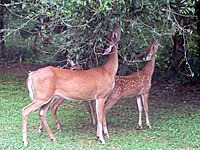
Highly invasive tree species are more dependent on mutualisms.
Sign Up to like & getrecommendations! Published in 2020 at "Ecology"
DOI: 10.1002/ecy.2997
Abstract: Why some species become invasive while others do not remains an elusive question. It has been proposed that invasive species should depend less on mutualisms, because their spread would then be less constrained by the… read more here.
Keywords: dependence; mycorrhizal fungi; invasive tree; highly invasive ... See more keywords

Contrasting impacts of highly invasive plant species on flower-visiting insect communities
Sign Up to like & getrecommendations! Published in 2018 at "Biodiversity and Conservation"
DOI: 10.1007/s10531-018-1525-y
Abstract: Invasive alien plants threaten biodiversity, ecosystems and service provision worldwide. They can have positive and negative direct and indirect effects on herbivorous insects, including those that provide pollination services. Here, we quantify how three highly… read more here.
Keywords: invasive plant; plant; plant species; insect communities ... See more keywords

Puccinia coronata var. coronata, a crown rust pathogen of two highly invasive species, is detected across the Midwest and Northeastern United States.
Sign Up to like & getrecommendations! Published in 2022 at "Plant disease"
DOI: 10.1094/pdis-07-22-1711-re
Abstract: Puccinia coronata var. coronata (Pcc) causes crown rust disease of glossy buckthorn (Frangula alnus) and reed canarygrass (Phalaris arundinacea), two highly invasive plant species in North America. Pcc is closely related to major pathogens of… read more here.
Keywords: crown rust; coronata var; two highly; var coronata ... See more keywords

Compartmentalized into Bacteriocytes but Highly Invasive: the Puzzling Case of the Co-Obligate Symbiont Serratia symbiotica in the Aphid Periphyllus lyropictus
Sign Up to like & getrecommendations! Published in 2022 at "Microbiology Spectrum"
DOI: 10.1128/spectrum.00457-22
Abstract: Multipartner nutritional endosymbioses have evolved many times in insects. In Chaitophorinae aphids, the eroded metabolic capabilities of the ancient obligate symbiont B. aphidicola are complemented by those of more recently acquired symbionts. ABSTRACT Dependence on… read more here.
Keywords: insects; symbiont; symbiotica; obligate symbiont ... See more keywords

Effects of Synbiotics to Prevent Postoperative Infectious Complications in Highly Invasive Abdominal Surgery
Sign Up to like & getrecommendations! Published in 2017 at "Annals of Nutrition and Metabolism"
DOI: 10.1159/000479920
Abstract: Postoperative infectious complication (POIC) is one of the most common complications following highly invasive abdominal surgeries, such as hepatectomy, esophagectomy, and pancreatoduodenectomy. The surgical stress temporarily deteriorates the intestinal microenvironment, and the fecal concentrations of… read more here.
Keywords: abdominal surgery; postoperative infectious; highly invasive; acid ... See more keywords

Isolation and characterization of 15 microsatellite markers for the highly invasive box tree moth Cydalima perspectalis (Lepidoptera: Crambidae)
Sign Up to like & getrecommendations! Published in 2018 at "European Journal of Endocrinology"
DOI: 10.14411/eje.2018.026
Abstract: In this study, we report the development of a set of 15 polymorphic microsatellite markers for the box tree moth, Cydalima perspectalis (Walker), a highly invasive insect in Europe causing significant damage to natural and… read more here.
Keywords: moth cydalima; box tree; tree moth; cydalima perspectalis ... See more keywords

Curcumin Treatment Identifies Therapeutic Targets within Biomarkers of Liver Colonization by Highly Invasive Mesothelioma Cells—Potential Links with Sarcomas
Sign Up to like & getrecommendations! Published in 2020 at "Cancers"
DOI: 10.3390/cancers12113384
Abstract: Simple Summary Aggressive sarcomatoid tumors designed in inbred strains of immunocompetent rats represent useful tools for both the identification of biomarkers of invasiveness and evaluation of innovative therapies. Our aim was to investigate the molecular… read more here.
Keywords: liver colonization; mesothelioma; therapeutic targets; colonization ... See more keywords

An Alkaloid from a Highly Invasive Seaweed Increases the Voracity and Reproductive Output of a Model Fish Species
Sign Up to like & getrecommendations! Published in 2022 at "Marine Drugs"
DOI: 10.3390/md20080513
Abstract: The invasive macroalga Caulerpa cylindracea has spread widely in the Mediterranean Sea, becoming a favorite food item for native fish for reasons yet unknown. By using a combination of behavioral, morphological, and molecular approaches, herein… read more here.
Keywords: alkaloid highly; model fish; model; invasive seaweed ... See more keywords

Synergistic Effect of Squalene and Hydroxytyrosol on Highly Invasive MDA-MB-231 Breast Cancer Cells
Sign Up to like & getrecommendations! Published in 2022 at "Nutrients"
DOI: 10.3390/nu14020255
Abstract: Several studies relate Mediterranean diet and virgin olive oil (VOO) intake with lower risk of several chronic diseases, including breast cancer. Many of them described antitumor properties of isolated minor compounds present in VOO, but… read more here.
Keywords: breast; mda 231; breast cancer; cancer cells ... See more keywords